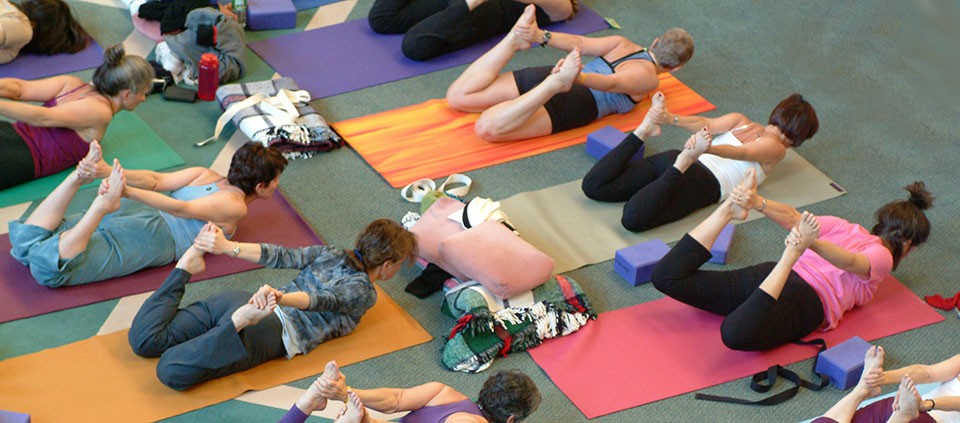Yin Yoga: Still, Deep, and Quiet

Our body is precious. It is our vehicle for awakening. Treat it with care.
—The Buddha
After practicing Yin Yoga for three years, I found that I had grown half an inch taller—surprising in my late 50s! I’ve been doing yoga for decades, so how did Yin Yoga make me taller?
In Yin Yoga, floor postures such as Frog, Pigeon, and Bound Angle are held from one to 10 minutes. The effect of gravity, over time, stretches and compresses the denser tissues, pushing out toxins, pulling in nutrients, and tugging on the joints, bones and fascia (connective tissue), especially in the spine, low back, hips, and thighs. Relaxing the muscles allows the joints to stretch toward their complete range of motion.
The result is greater ease of motion with less effort. We feel more relaxed and lighter when we free up adhesions and “gluing” that solidify the fascia, due to aging, injury, and lifestyle. And yes, we may even become taller as our alignment and the denser tissues respond to stretching. We feel more comfortable at the core, because the fascia that fasten the body together and the ligaments that link the bones are hydrated.
Yin and Yang Yoga
The experience of oneness is the overall aim of yoga, though each yoga practice has its purpose, methods, and results. The body responds to physical pressure in predictable ways. Appropriate stress and rest engages an adaptive repair-response that stimulates the vitality of the tissues. The great “yinsight” of Taoist Yoga is to divide asana practice into two kinds: Yin and Yang, depending upon the nature of the tissue being addressed.
Yang Yoga strengthens yang tissues: the muscles, which are soft, superficial, and elastic. Muscles respond to movement, repetition, and rhythm by lengthening, contracting, and heating. Yang poses use muscles to hug the core, from skin to bone. In Triangle pose, for example, we strengthen muscles by engaging upper and lower body, adjusting the pelvis to stabilize the core, and contracting the muscles of the pelvic floor to protect the joints of the low back.
In Yin Yoga, we relax the muscles in order to stress the joints, thus restoring, enhancing, and preserving the range of motion in the joints. Yin Yoga complements Yang Yoga by rehabilitating and strengthening yin tissues—the bones, ligaments, and fascia: the deeper, denser, more hidden connective tissue.
Fascia: The Body’s Support System
New evidence shows that fascia is the fabric of life. Fascia is a living crystalline web through which meridians, or nadis, weave the bioelectric signals of vital life force, prana, or chi. Fascia is the body’s structural and energetic support system. Fascia binds and protects all the other tissues in the body and offers a medium of conductivity. Yin postures enhance this matrix of matter and energy—the meridian and organ systems—by targeting attention to and moisturizing these psycho- spiritual, emotional, energetic, and physical pathways.
Every muscle cell is wrapped in fascia; every muscle tissue, bundle, and group, and every joint, is layered in fascia. Overnight, the body literally “shrink-wraps” itself through contracting of the fascia. That’s why it feels so good to yawn and stretch in the morning. (Another way to get the benefit of yin tissue realignment is to receive a session of shiatsu or Thai massage.)
Yin Yoga For All
Yin poses are still, deep, and quiet. The atmosphere of a Yin Yoga class is unhurried, internal, and relaxed, with a focus on self-exploration and discovery. Students are encouraged to experiment with the poses, since skeletal variation—the proportion and orientation of the bones—is different for each person. Alignment is everything—and not the same for every body. Understanding how anatomical differences affect joint mobility helps students to appreciate their own unique range of motion.
Yin Yoga is growing in popularity because everyone can do it. Many students learn to let go of unfairly comparing themselves with models doing pretzel poses on magazine covers. They drop the idea of how the posture is “supposed to” look—in a super-agile, bendy body, or in a mythical image—and awaken to the living relationship of posture to breath. Learning Yin Yoga poses not only helps improve range of motion, it also empowers practitioners toward freedom and choice in all spheres of life.
© Kripalu Center for Yoga & Health. All rights reserved. To request permission to reprint, please e-mail editor@kripalu.org.
Ken Nelson, PhD, Kripalu Legacy Faculty member, is dedicated to helping people heal, grow, and awaken with mind-body practices and the wisdom traditions.
Full Bio and Programs